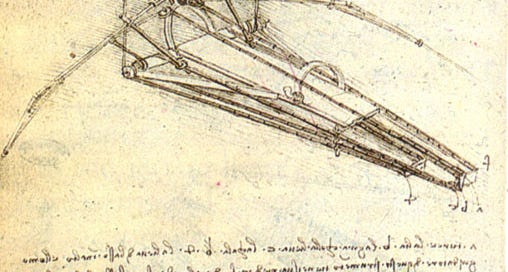Simplicity is the ultimate sophistication
If it's good enough for Da Vinci's plans, maybe it's good enough for you.
How many times have couples gotten into an argument because one said, “You’re making this more complicated than it needs to be” or “Stop overthinking this.”
The most effective solutions are often the simplest. The best software design is not necessarily the one with the most bells and whistles, but rather the one that achieves its purpose with the fewest elements or steps. The same can be true for a bicycle, coffee maker, or TV.
Apple and Google have built their brands on simple, user-friendly designs, and many successful startups have followed suit. By prioritizing simplicity, these companies are able to create products that are intuitive and easy to use, and that appeal to a wide range of customers.
Leonardo da Vinci was a master of simplicity in design, and his legacy has had a lasting impact on the world of art and technology. Even his notebooks are filled with clear, concise notes and drawings that break down complex ideas into simple, understandable concepts. Da Vinci's sketches and plans for flying machines, water pumps, and weapons of war were based on simple, natural forms. It took skill and sophistication to manufacture his products, but the design elements themselves were straightforward.
Simplicity is the ultimate sophistication. —Leonardo da Vinci
Other inventors of the time developed plans for flying machines that had elaborate designs with multiple wings and complex mechanisms. They overthought everything to the point that they missed the big picture: a practical method of flight. Da Vinci’s ornithopter had a simple design with just one pair of wings that flapped up and down like those of a bird. Simple, effective, and efficient.


City planners overcomplicate things.
Some policy projects are complex, like updating a zoning ordinance that is consistent with the approved comprehensive plan and gives clarity for development review without contradicting state codes. But the premise is simple: legalize housing.
Some infrastructure projects are complex, like designing a pedestrian detection system in an autonomous vehicle. But the premise is simple: design a driverless vehicle that prioritizes pedestrian safety over vehicular safety.
I'm not suggesting that details aren't important in the design and construction process. But when it comes to urban planning, it's crucial to keep the "Why" in mind. The big picture.
Daniel Burnham, one of planning’s heroes made this now-famous statement:
"Make no little plans. They have no magic to stir men's blood and probably themselves will not be realized. Make big plans; aim high in hope and work, remembering that a noble, logical diagram once recorded will never die, but long after we are gone will be a living thing, asserting itself with ever-growing insistency."
Burnham's quote gets twisted as a call to orchestrate every aspect of a city's development from the top down. But his intent was to encourage city planners to dream up big ideas, not big hoops to jump through and big obstacles to halt progress. He created the 1909 Plan of Chicago with Edward Bennett, as a groundbreaking and ambitious plan to alter the city's transportation system, parks and public spaces, and civic buildings.
Burnham knew that creating bold and ambitious plans would ignite people's passion and enthusiasm for urban development, and that these plans would serve as a roadmap for the future growth and success of a city. Visionary plans inspire and motivate people, even if the vision begins with small, incremental changes. The plan itself can be simple and clear, no matter how much complexity is required for implementation.
Planners get this backwards. They make overly burdensome plans that include a million simple (and agonizing and costly) steps. It might be because in Burnham’s era, planners were so closely intertwined with landscape design and building architecture.
Entrepreneurs and small business owners have been onto this idea of simplicity for a long time. I’ve heard several interviews with successful owners who point to a 1-page business plan as the key to success. Planners should steal that strategy.
Start by crafting 1-sentence purpose statements for every plan, whether it's a transportation plan, parking study, downtown revitalization study, housing study, or anything else. Then, when you’re inevitably hit with rabbit-hole questions at a public hearing, you can always elevate the conversation back up to that simple purpose statement.
Some examples that come to mind:
Townhouses should be legal.
City streets should be designed for 20mph traffic.
Homeowners should be allowed to rent portions of their house.
Converting a shed to a music studio should be legal.
Minimum parking mandates should be abolished.




Radical simplicity is very powerful.
No city has ever become more affordable by making housing harder & more complicated to build